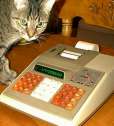Casio FX-820P
| Datasheet legend
Ab/c:
Fractions calculation
AC: Alternating current BaseN: Number base calculations Card: Magnetic card storage Cmem: Continuous memory Cond: Conditional execution Const: Scientific constants Cplx: Complex number arithmetic DC: Direct current Eqlib: Equation library Exp: Exponential/log functions Fin: Financial functions Grph: Graphing capability Hyp: Hyperbolic functions Ind: Indirect addressing Intg: Numerical integration Jump: Unconditional jump (GOTO) Lbl: Program labels LCD: Liquid Crystal Display LED: Light-Emitting Diode Li-ion: Li-ion rechargeable battery Lreg: Linear regression (2-var. stats) mA: Milliamperes of current Mtrx: Matrix support NiCd: Nickel-Cadmium recharg. batt. NiMH: Nickel-metal-hydrite rech. batt. Prnt: Printer RTC: Real-time clock Sdev: Standard deviation (1-var. stats) Solv: Equation solver Subr: Subroutine call capability Symb: Symbolic computing Tape: Magnetic tape storage Trig: Trigonometric functions Units: Unit conversions VAC: Volts AC VDC: Volts DC |
| ||||||||||||||||||||||||||||||||||||||||||||||||||||||||
Casio FX-820P
*Requires RAM card for operation
 The fx-820P is a printing member of Casio's BASIC pocket computer line. Even with a small thermal printer built-in, the device remains fairly small, compact, and usable. The built-in BASIC interpreter is the same interpreter found in literally dozens of different Casio models sold since the mid 1980s.
The fx-820P is a printing member of Casio's BASIC pocket computer line. Even with a small thermal printer built-in, the device remains fairly small, compact, and usable. The built-in BASIC interpreter is the same interpreter found in literally dozens of different Casio models sold since the mid 1980s.
In other words, this machine is, well, slightly boring. No wonder I was admonished by Hugh Steers when he saw that the Gamma function examples I supply on these pages do nothing to alleviate the boredom! So, he sent me his own: an implementation in Casio BASIC that uses the Lanczos-approximation, but elegantly, computes the Lanczos coefficients on the fly, and does so within a reasonable amount of time, and with good precision. Apart from serving as evidence of Hugh's programming skills, the program also demonstrates just how useful and practical these handheld devices can be, even with their limited processing power and memory:
10 VAC:INPUT Z 20 H=1:A=-1:B=2 30 N=EXP 5.5/SQR 5.5 40 W=N/2:Y=.5:X=1:U=1 50 X=X*(Z+(1-U))/(Z+U) 60 N(U)=Y*EXP(U+5.5-LN(U+5.5)*(U+.5)):Y=Y*(U+.5) 70 FOR V=0 TO U:W=W+X*A(V)*N(V):NEXT V 80 IF U=6 THEN 130 90 T=A:FOR V=0 TO U 100 H(V)=2*T-H(V):T=B(V) 110 B(V)=2*H(V)-B(V):NEXT V 120 A=-A:U=U+1:GOTO 50 130 T=Z+.5:T=2*W*EXP(T*LN(T+5)-T-5)/Z 140 PRINT T


